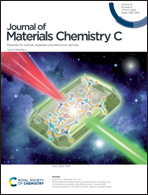Simultaneous microwave-assisted reduction and B/N co-doping of graphene oxide for selective recognition of VOCs†
Abstract
Herein, the influence of heteroatom domains on the volatile organic compound (VOC) detection properties of B/N co-doped graphene oxide nanostructures was investigated by using different boron (B) and nitrogen (N) sources, in the form of ammonia borane (AB) and tetramethylammonium borohydride (TMABH). XPS studies revealed the dependence of bonding configurations on the choice of the doping material, with AB co-doping leading to predominant hBN domains with a B : N ratio of 0.5, whilst TMABH co-doping resulted in predominantly BC3 and N–C bonds. Furthermore, Raman analysis showed that AB promoted rGO lattice restoration and the formation of larger crystallites. Upon VOC screening, the BN-rGOAB sample responded to both methanol and ethanol vapours, while the BN-rGOTMABH sample responded only to methanol vapour. Most importantly, B/N co-doping promoted better stability of up to ∼3 weeks with improved selectivity to methanol and/or ethanol in a mixture of VOC vapours. The study showed the significance of B and N configurations on the charge carrier transport properties of B/N co-doped graphene nanostructures for application in room temperature VOC sensing devices.



 Please wait while we load your content...
Please wait while we load your content...